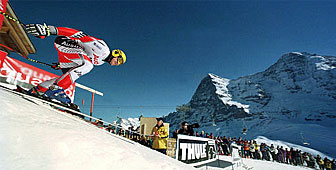The legend of Wengen and the Lauberhorn

The classic Lauberhorn downhill ski race puts the spotlight on the Bernese Oberland resort of Wengen for one weekend a year. But Wengen is quite unique in its own right, as a visit on any winter's day proves.
Every journey up to Wengen starts at the train station in the village of Lauterbrunnen in the valley below. Tourists, residents and supplies for the resort are loaded onto the green and yellow carriages of the rack railway for the 15-minute trip up to the village.
The railway does a thriving business since Wengen – lying on a shelf 1,300 metres above sea level – is a car free resort.
It’s a trip one of Wengen’s better-known residents has been making for most of his 55 years. “Once I park my car in Lauterbrunnen and board the train, I tell myself to relax, take a deep breath and sit back and enjoy,” says Stefan Zürcher.
Zürcher is a former stuntman who now runs his own film production company. “It’s another world thanks to the fresh air and the car free streets.”
He made a name for himself performing death-defying feats on skis in feature films, including the James Bond movie “On Her Majesty’s Secret Service” and Robert Redford’s “Downhill Racer”, both of which were shot in the area.
Skiing was always a way of life for Zürcher. He used to ski to school, and in his reckless teenage years started jumping over cliffs and skiing through the trees.
“At one point I realised that a profession is something you’re good at and I knew I was a good skier so I tried making it my profession.”
The starting gates of the Lauberhorn race, first run in 1930, stand on an exposed ridge 2,500 metres above sea level. Before the world’s top skiers shoot out of the gates, they have one last chance to look across for inspiration at the world of glaciers climbing the steep slopes of the Eiger, Mönch and Jungfrau mountains.
On this day, Zürcher takes an inquisitive journalist down the Lauberhorn. At more than four kilometres in length, it’s the longest downhill race on the World Cup circuit, and offers enough perils in the first few hundred metres to have sent many a top skier crashing.
“It’s quite impressive if you realise that racers come into the “Hundschopf” hairpin turn at 80 kilometres an hour and then go directly into an overhang,” Zürcher says.
With a relaxed swivel of his hips, he glides smoothly through the Hundschopf and waits for the journalist, who tumbles backwards to avoid turning immediately into the steep overhang below. Zürcher can’t hold back a smile.
Tourism arrived in earnest in Wengen at the end of the 19th century with the completion of the railway up to the Kleine Scheidegg – the high plateau directly below the Eiger, Mönch and Jungfrau.
The train still passes the Hotel Wengernalp, as it did then, just before it reaches the plateau. The Bellevue hotel sits just beyond the Kleine Scheidegg station. Both hotels are exquisite leftovers from the Belle Époque and their past owners had much to do with developing alpine skiing.
Zürcher breaks off from the Lauberhorn slopes and skis up to the Hotel Wengernalp, and orders a coffee. He likes the hotel’s old-fashioned style and comfort, and is always welcomed by owner Urs von Almen.
The two hotels have been in the Von Almen family for generations and it was Urs’ grandfather who founded the Ski Club Scheidegg in 1925 to promote winter tourism. It was only three years after the pioneering Englishman, Sir Arnold Lunn, organised the first slalom race in alpine skiing history across the valley in Mürren.
Urs von Almen says Lunn was one of many illustrious guests who stayed at the Hotel Wengernalp. The British led the way, and were soon followed by the artistic and intellectual elite from across Europe. Wagner, Mendelssohn, Marx and Engels all took rooms at the Wengernalp.
To this day, the hotel still retains an old English air to it.
“All the guests were fascinated by being able to observe the glaciers from such a short distance,” says Von Almen. “There are few other hotels that can offer such close views of the Alps.”
Zürcher orders lunch and Von Almen recommends the wine. Above the hotel, the next generation of Swiss professional skiers try their luck on the Lauberhorn – outfitted with the latest high tech ski equipment.
It’s a far cry from the primitive gear Von Almen’s grandfather promoted, or even the wooden skis Zürcher remembers still being used up until the 1960s.
Thanks to the hotel Wengernalp, those memories are still alive and well.
by Dale Bechtel

In compliance with the JTI standards
More: SWI swissinfo.ch certified by the Journalism Trust Initiative

You can find an overview of ongoing debates with our journalists here. Please join us!
If you want to start a conversation about a topic raised in this article or want to report factual errors, email us at english@swissinfo.ch.